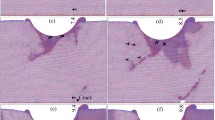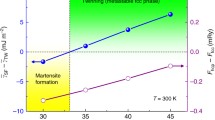Abstract
The regular twinning in ceramics and metals below the temperature of a ferroelastic or ferroelectric structural phase transition is a result of energy minimization. Here homogeneous elastic energy is reduced at the expense of twin wall energy. The twin density depends on the gram sizeg; under homogeneous stress the total elastic energy of a grain increases ∝g 3. Any kind of twin wall, however, increases ∝g 2. Below the intersection of these two curves, stress reduction by twinning cannot lower the total energy. Thus there is a critical grain size below which twinning should not occur. Above this limit the width of the twin lamellae increases ∝g 1/2. The shape of the grain then adjusts to the surroundings in two dimensions only. Above another larger critical grain size more complex interfaces with higher surface energy are created, which allow stress relief in the third dimension. A semi-quantitative model is developed with the example of BaTiO3 ceramic, of which the domain patterns are well known. It is representative for many ceramics. The highT c superconductor YBa2Cu3O7−δ also twins according to the same law. For three-dimensional adjustment here a proper interface is missing.
Similar content being viewed by others
References
R. W. Cahn,Adv. Phys. 3 (1954) 363.
J. W. Christian, in “The Mechanism of Phase Transformations in Crystalline Solids”, Monograph and Report Series Vol. 33 (Institute of Metals London, 1969) p. 129.
C. M. Waymann, in “Diffraction and Imaging” Technique in Materials Science edited by S. Amelinckx, R. Gevers and I. van Landuyt (North Holland, 1978) pp. 251ff.
A. Johnson, “Neues Jahrbuch Mineralogie”, Beilage-band39 (1914) p. 500.
K. Aizu.J. Phys. Soc. Jpn 27 (1969) 387.
Idem, ibid. 32 (1971) 1959.
L. S. Fomenko, S. V. Lubenets andV. I. Startsev Scripta Metall. 18 (1984) 535.
H. M. O'Bryan andP. K. Gallagher,Adv. Ceram. Mater. 2 (1987) 640.
T. J. Kistenmacher,J. Appl. Phys. 64 (1988) 5067.
C. Willaime andM. Gandais,Phys. Status Solidi (a) 9 (1972) 529.
C. Willaime, W. L. Brown andM. Gandais, in “Electron Microscopy”, edited by H.-R. Wenk (Springer, Berlin 1976) Ch. 4.9.
P. E. Champness andG. W. Lorimer,ibid.“ Ch. 4.1.
G. Arlt andP. Sasko,J. Appl. Phys. 51 (1980) 4956.
G. Arlt, D. Hennings andG. deWith,ibid. 58 (1985) 1619.
J. D. Eshelby, in “Progress in Solid Mechanics” Vol. 2 (North-Holland, Amsterdam, 1961) pp. 89–140.
G. Arlt, H. Dederichs andR. Herbiet,Ferroelectrics 74 (1987) 37.
O. M. Zhang et al., J. Appl. Phys. 64 (1988) 6445.
P. T. Worrell,ibid. 19 (1948) 927.
C. Zener, “Elasticity and Anelasticity in Metals”, (University Press, Chicago, 1948) p. 159.
J. W. Christian,Metall. Trans. A. 13A (1982) 509.
V. A. Zhirnov,Sov. Phys. JETP 35 (1959) 822.
L. N. Bulaewski,Sov. Phys. Sol. State 5 (1964) 2329.
C. Kittel,Sol. State Commun. 10 (1972) 119.
M. Distelhorst, R. Hofmann andH. Beige,Jap. J. Appl. Phys. 24 (1985) Suppl.24-2 (1985) 1019.
J. F. Smith andD. Wohlleben,Z. Phys. B Cond. Matt. 72 (1988) 323.
G. v. Tendeloo, H. W. Zandbergen andS. Amelinckx,Sol. State Commun. 63 (1987) 603.
M. Tanaka andG. Honjo,J. Phys. Soc. Jpn 19 (1964) 954.
T. Malis andH. Gleiter,J. Appl. Phys. 47 (1976) 5195.
Y. J. Chang.Appl. Phys. A29 (1982) 237.
Author information
Authors and Affiliations
Rights and permissions
About this article
Cite this article
Arlt, G. Twinning in ferroelectric and ferroelastic ceramics: stress relief. J Mater Sci 25, 2655–2666 (1990). https://doi.org/10.1007/BF00584864
Received:
Accepted:
Issue Date:
DOI: https://doi.org/10.1007/BF00584864




